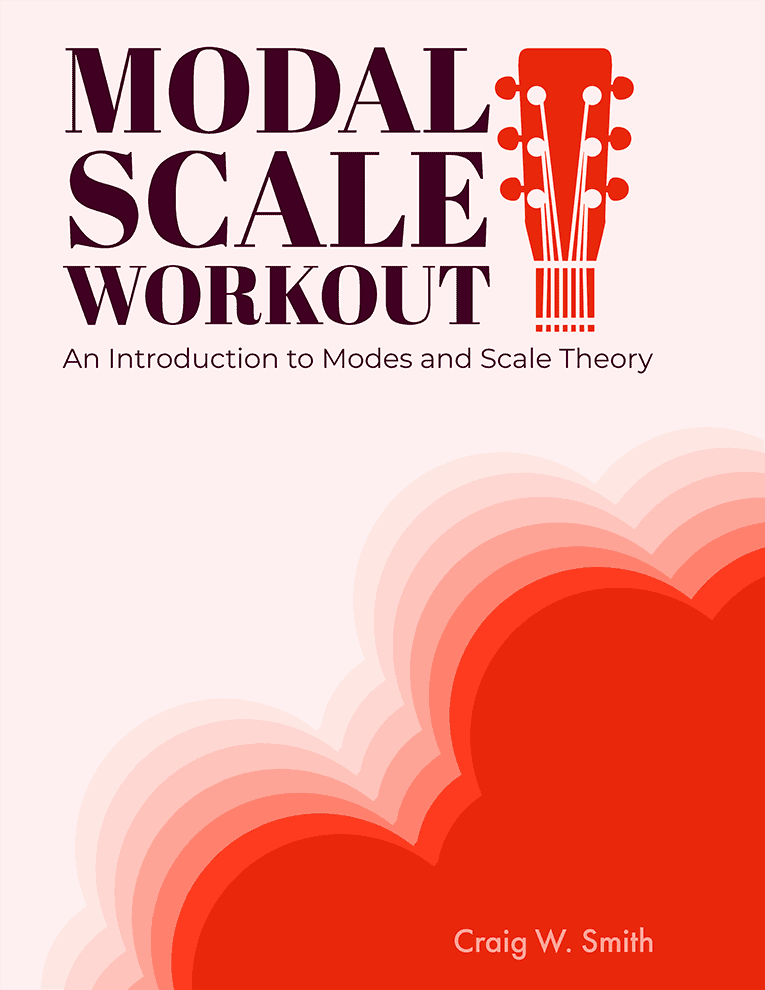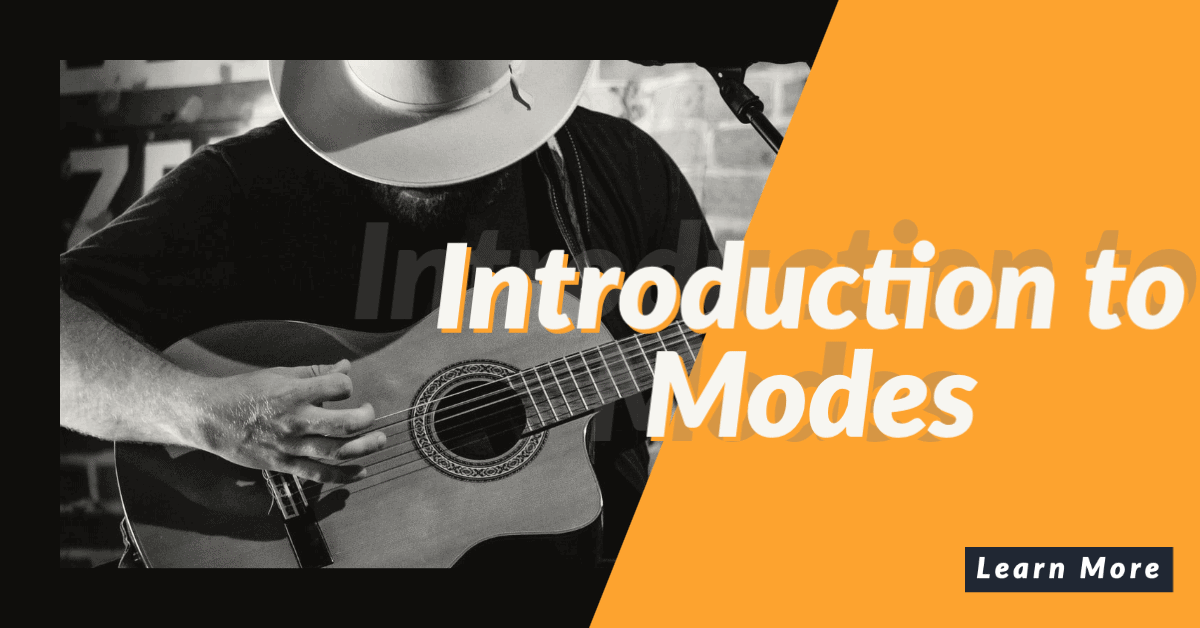Introduction to Modal Scales for Guitarists
I know what you’re thinking. Oh, great. Another article on guitar scales. You may be asking yourself the usual questions:
- Why do I need to learn modal scales?
- Why do modal scales have such funny names?
- Are these scales really going to make me better?
- Can I use modes in my everyday guitar playing situations?
These are the same things I asked myself over 30 years ago when I first started using the Modal Scales in my everyday guitar playing.
I remember back in the late 1980’s when I was first starting out on the guitar, reading about these mysterious scales in magazine interviews with guitar giants such as Randy Rhoads, Joe Satriani, Steve, Vai, and Frank Zappa.
Modes on Guitar every Day
Growing up on a steady diet of Classic Rock, Blues and Metal, it would seem everything I needed could be found inside Pentatonic “blues Box” shapes. Wow, was I wrong!
After playing guitar for a few years and taking my own studies deeper into music theory and improvisation, I would find more and more new shapes and ideas that would center around a modal approach to writing and improvising.
In this modes for beginners guide (an excerpt from my upcoming book), I hope to spark the same fire in you that I found when I first discovered modal scales.
What Can Modal Scales Do For You as Guitarist?
There are many ways in which to use modal scales both as a musical device to achieve a certain mood or texture as well as a tool from which you can cover the entire guitar fretboard in any key or scale using symmetrical patterns.
For the purposes of this book, we will be talking primarily about the latter. Using modes around a Key Center from which to build solos, melodies, riffs and other melodic functions.
How many patterns do you need to learn? Seven to be exact. Yes, thats it. 7 simple patterns. But wait, theres more….
7 Modal Scale Patterns
Inside these 7 Modal Scale patterns lie all of the chords, arpeggios, Pentatonic Scales and literally everything else you can do in a given key.
By learning the 7 Modal Scale patterns you are in essence creating a fool-proof blueprint from which to play all of the “good notes”all over the guitar neck… and thats just the beginning.

Once you’re comfortable with different modes, you can substitute and super-impose other modes to achieve a greater sophistication in your soloing and compositions.
Practicing Modal Scales on guitar also has a wonderful side effect which should become apparent even on your first day. Technique building, chops exploding, strengthening of both hands!… and that frankly, is the easy part. There is just no downside to getting these scales under your fingers.
Before we get into some of the theory of modal scales on guitar, you may want to download or print up the shapes. I’ve written a few other lessons on this website you may also want to check out:
- If you’re completely new to scales, check out the Circle of Keys and guitar scale lesson.
- If you just need some shapes, here you can download all 7 guitar mode shapes in .PDF format.
- If you want to see how chords and modes overlap, check out my Guitar Modes – A Practical Guide lesson.
What is a Scale?
By definition, “In music theory, a scale is any set of musical notes ordered by fundamental frequency or pitch. A scale ordered by increasing pitch is an ascending scale, and a scale ordered by decreasing pitch is a descending scale”
Or in lay terms, alphabetically from A to G.
For example the C Major Scale:
C D E F G A B C
The Major scale is the foundation for all other scales, chords arpeggios.. really anything you’re going to do on the Guitar (or any other instrument).
The Major Scale:
- A Major Scale has 8 notes in alphabetical order.
- Has a set interval pattern, (the space between scale tones) for every key:
Whole, Whole, Half, Whole, Whole, Whole, Half
If you’re completely new to music theory, think of a whole step as 2 frets distance on the guitar and a half step as 1 fret.
There are always half steps between the notes B-C and E-F.
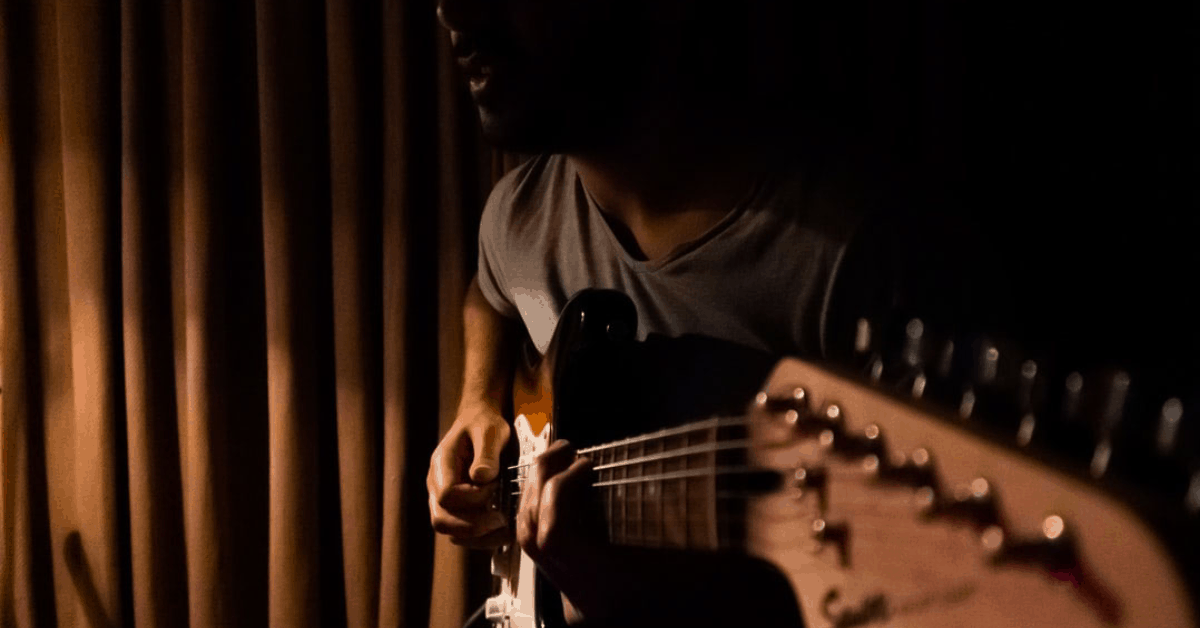
What is a Mode?
The easiest (or simplest) way to think of a mode is to just think of each mode as a new scale built on a degree of an existing Major scale.
In the Key of C, we have 7 (different) notes:
- C
- D
- E
- F
- G
- A
- B
If we build a scale on each of the 7 notes, without changing anything, we get the 7 modal scales in the key of C:
- CDEFGABC – Ionian
- DEFGABCD – Dorian
- EFGABCDE – Phyrgian
- FGABCDEF – Lydian
- GABCDEFG – Mixolydian
- ABCDEFGA – Aeolian
- BCDEFGAB – Locrian
Lets try some simple, single-octave shapes on the guitar:
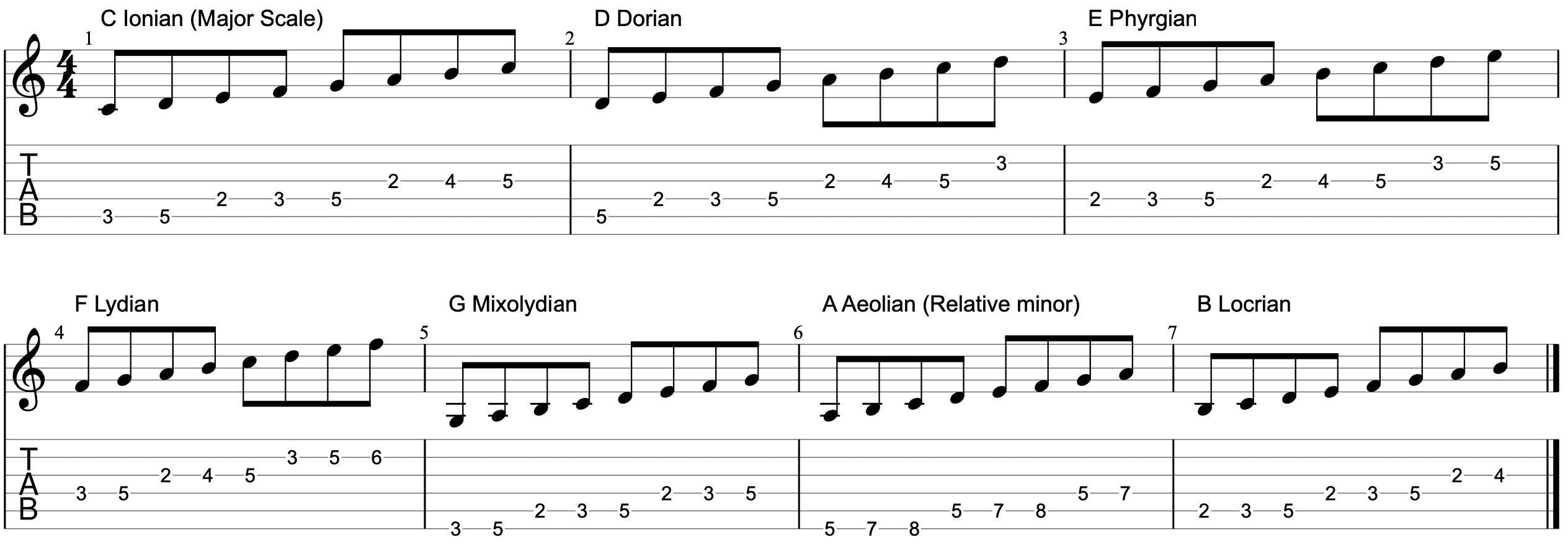
Let’s try it in another key, G Major
The G Major Scale consists of these notes:
G A B C D E F# G
Ionian
The first Diatonic mode Ionian, is synonymous with a Major Scale. You could call the above scale, G Major or G Ionian.
Dorian
To build the next mode, simply start on the next note (A) and build a new scale:
A B C D E F# G A – (notice I didn’t change any notes)
We now have the A Dorian Scale.
Phrygian
Starting on the next note (B) we can build B Phrygian:
B C D E F# G A B (same notes, just starting on B)
We didn’t change the notes, we just built a new scale on each subsequent note. A Dorian is not an A Major scale (A B C# D E F# G# A). It is simply a G Major scale starting on the second degree (A). Lets finish the modes in the key of G:

Here is a printable PDF of all the Guitar Mode Shapes.
Lydian
Starting on the 4th note, C, we can build our C Lydian Scale:
C D E F# G A B C
Mixolydian
Next up, our 5th mode is Mixolydian starting on D:
D E F# G A B C D
Aeolian
Aeolian is the relative minor or natural minor scale. The 6th note in the key of G is E, so we’ll build our Aeolian scale starting there: E F# G A B C D E
Note: Keep in mind the 6th degree (relative minor) is also the best place to start our minor Pentatonic and Blue Scale guitar shapes.
Locrian
Locrian is the last mode. The 7th note in the key of g is F#, so we’ll build the scale from there.
F# G A B C D E F#
Some Thoughts on Modes For Guitar
“In the theory of Western music, a mode is a type of musical scale coupled with a set of characteristic melodic behaviors. Musical modes have been a part of western musical thought since the Middle Ages, and were inspired by the theory of ancient Greek music. The name mode derives from the Latin word modus, “measure, standard, manner, way, size, limit of quantity, method”
Funny names, hard to spell. Who cares? Well, the Ancient Greeks were on to something despite the difficult names. Why not just number them? Music theory, especially those topics pertaining to the Major Scale and modes have been basically unchanged for over 500 years. Yes, 500 years!
There are so many different ways to think of modes. Heres a random example using Dorian:
- A Dorian is the 2nd Mode of the Key of G.
- You could think of A Dorian as an A Major Scale with a b3 and b7, or just think of it as the second mode (ii minor) in G Major.
- I could also think of A Dorian as an A Natural Minor Scale with a raised 6th. Mind blown!
If you liked this article signup for my email list below and be among the first to grab the full book coming later in 2020.
In the meantime, check out this Guitar Modes: A Practical Guide lesson and get going on some shapes.
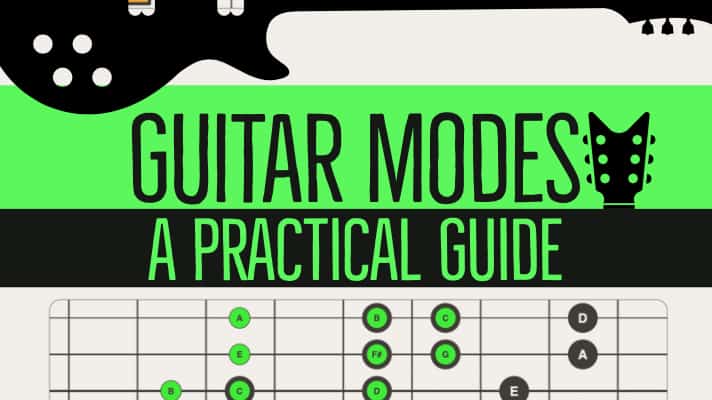
Modal Characteristics
Before we start actually playing these scales, let’s take one more run through to address some theoretical views on modes. All modes have distinctive characteristics and personalities that make them special and different from one another.
Lets explore some modal theory using the key of C for all examples below:
C D E F G A B C (Parent Major Key)
Ionian
- Ionian is synonymous with the Major Scale. They are one and the same.
- Can use Major Pentatonic on same root.
- Ionian is a happy and bright scale. Pop, Rock, Country Music etc..
C Major/Ionian Scale: C D E F G A B C
Dorian
- Dorian is a minor type scale.
- It is the 2nd mode in every key.
- Can use minor pentatonic on same root.
- Dorian contains a lowered 3rd and 7th degree from its Major parent scale.
- Dorian is somewhat dark and bluesy. Latin, Blues, Rock.
C Dorian – C D Eb F G A Bb
Phrygian
- Phrygian is a minor type scale.
- It is the 3rd mode in every key.
- Can use minor pentatonic on same root.
- Phrygian contains a lowered 2nd, 3rd, 6th and 7th from its parent major.
- Very dark, almost Spanish sounding, exotic. Flamenco, Metal, Prog.
C Phrygian – C Dd Eb F G Ab Bb C
Lydian
- Lydian is a Major type scale
- It is the 4th mode in every key.
- Can use the Major Pentatonic on the same root.
- Lydian’s only change from its parent Major (Ionian) is the raised 4th.
- Airy, dreamy quality.
C Lydian – C D E F# G A B C
Mixolydian
- Mixolydian is a Major type scale.
- It is the 5th mode of every key.
- Can use the Major pentatonic on same root.
- Mixolydian contains a lowered 7th from its parent major.
- Jazzy, Bluesy, more depth than Ionian.
C Mixolydian – C D E F G A Bb C
Aeolian
- Aeolian is a minor type scale. It is the relative or natural minor of every key.
- It is the 6th mode of every key.
- Can use the minor pentatonic and Blues Scale on same root.
- Aeolian contains a lowered 3rd, 6th and 7th from its parent major.
- Darker than dorian, not as dark as Phrygian. Works well in Blues, Rock & Metal.
C Aeolian – C D Eb F G Ab Bb C
Locrian
- Locrian is a minor type scale. Can also be thought of as diminished.
- It is the 7th mode of every key.
- Pentatonic Major and minor scales do NOT work on the 7th root.
- Locrian has a lowered 2nd, 3rd, 5th, 6th and 7th.
- Very dark!
C Locrian – C Db Eb F Gb Ab Bb C
If you enjoyed this lesson, consider picking up my 7 Day Practice Routine for Guitarists or my complete book on guitar modal scales.
Craig Smith is a professional Guitarist, Teacher, and Writer living in Sanford, Florida. Craig has taught guitar lessons, performed 200+ gigs per year for nearly 30 years, and published 4 guitar instructional books. When he’s not gigging or writing, you may find him by the pool with his wife Celeste, 4 Chihuahuas, and a drink. 🎸
